MASTERING SELF-DEFENSE AWARENESS: COOPERS COLOR CODES EXPLAINED
In today’s blog post, we explore the principles of Cooper’s Color Codes of Awareness. This framework can enhance your self defense skills. Understanding the color codes will improve situational awareness and help you respond better to potential threats. Join us as we explain each level of awareness and provide practical tips for applying these concepts to your self-defense strategy.
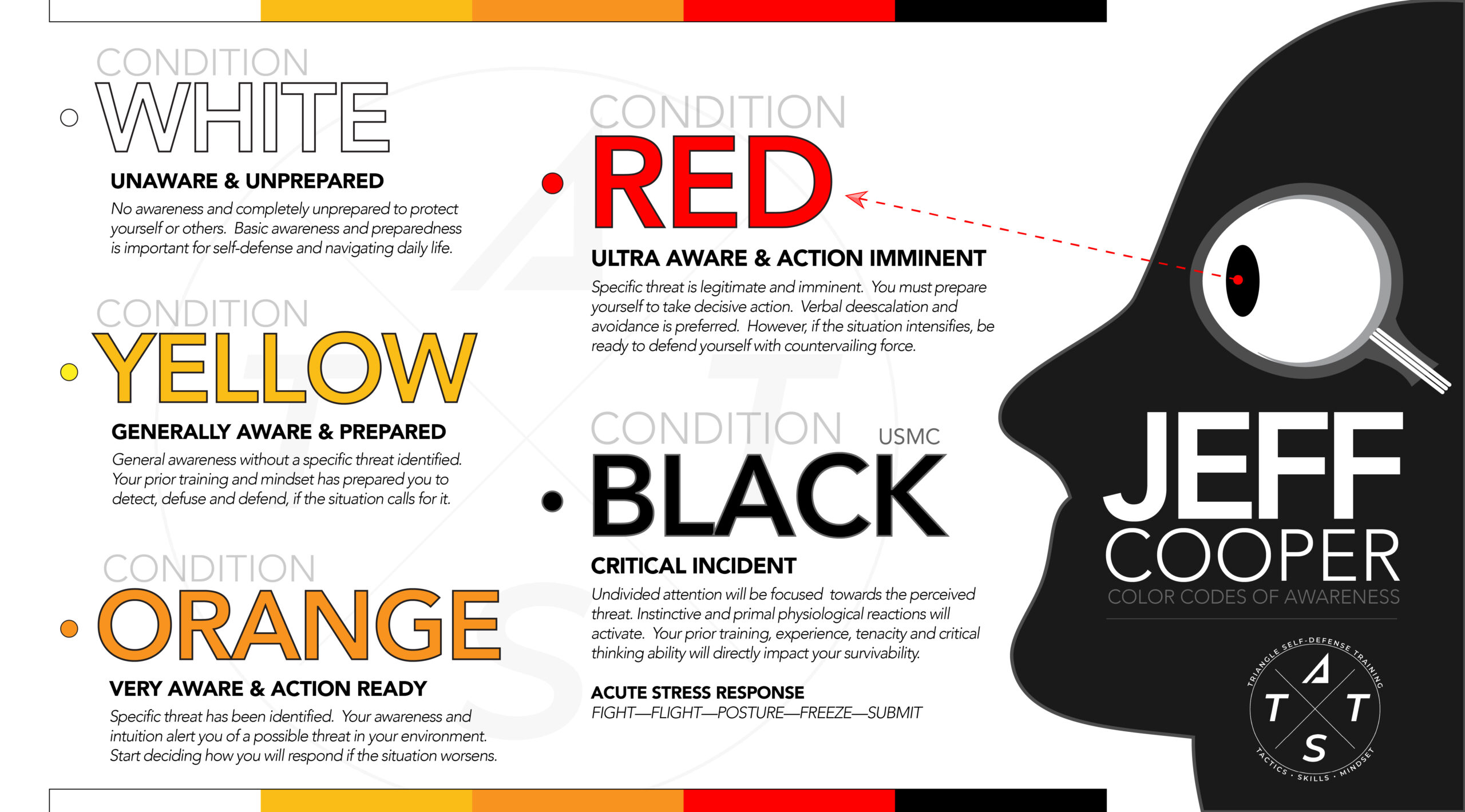
Table Of Contents Quick Links
| Who Was Colonel Jeff Cooper? |
| The Book That Changed The Game |
| Combat Mindset & Color Codes |
| Color Code Conditions Explained |
| Closing Thoughts & Key Takeaways |
| Self Defense Awareness Graphic |
WHO WAS COLONEL JEFF COOPER?
Lt. Col. Cooper was a U.S. Marine Corps veteran who served in World War II and the Korean War. He passed away in 2006 at the age of 86. He is regarded as one of the nation’s top experts in defensive pistolcraft and personal defense philosophy. His teachings on firearm skills and mental conditioning earned him respect in the self-defense and firearms training communities. Cooper stressed the importance of mindset and critical thinking in defense strategies, core principles of his teachings.
Colonel Cooper’s Key Contribution: Color Code System
One of Col. Cooper’s key contributions was the Color Code Awareness System. This approach helps individuals navigate dangerous situations with a clear structure. It trains people to adjust their awareness levels in response to potential threats, improving reaction time. Through these methods, Col. Cooper had a profound impact on modern self-defense training.
PRINCIPLES OF PERSONAL DEFENSE
Col. Cooper authored the respected self-defense book, Principles of Personal Defense. Many self-defense books focus solely on physical techniques. Cooper’s work stands out by emphasizing the mental aspect of self-defense. He understood that a well-trained mind paired with awareness is as essential as physical skills in facing threats. Cooper explores how cultivating a defensive mindset and staying mentally prepared are crucial for survival in high-stress situations.
The 7 Principles
Principles of Personal Defense offers strategies that apply to everyday life. It encourages instinctive responses over relying solely on combat techniques. The book outlines seven principles that show how a combat-ready mindset can improve your odds in confrontations—Alertness, Decisiveness, Aggressiveness, Speed, Coolness, Ruthlessness and Surprise. Cooper’s insights go beyond basic defensive tactics. He teaches you to anticipate danger, make quick decisions, and act effectively when your safety is threatened. If you haven’t read it yet, I encourage you to get a copy.
COMBAT MINDSET & THE COLOR CODES
Col. Jeff Cooper’s Color Code system is a vital framework for developing a combat mindset. It emphasizes mental readiness over physical or technical skills. The system breaks down awareness into escalating levels of readiness, from Condition White to Condition Red. Each level reflects the perceived threat. A combat mindset requires rapid assessment of these conditions, ensuring you are mentally prepared to act in dangerous situations. Cooper taught that no matter how skilled you are physically, those skills are less effective if your mind isn’t engaged.
Military Training Adapted For Civilian Self-Defense
Cooper’s system originated from military training but was adapted for civilian self-defense. It helps individuals stay mentally sharp and prepared under stress. The combat mindset requires constant awareness and adaptation to your surroundings. This ensures you can transition between conditions based on the perceived threat. Mastering this mental state allows you to react effectively. Whether you de-escalate, flee, or engage in self-defense, your readiness determines your response.

COLOR CODE CONDITIONS EXPLAINED
The Color Code system is invaluable for self-defense, readiness, and personal protection. It offers a clear framework for adjusting one’s mental state in the face of dangerous situations and threatening people. Unlike general situational awareness, Cooper’s Color Codes of Awareness emphasizes the importance of mental preparedness in combat or high-stress situations.
The system allows individuals to transition from a relaxed, unprepared state (Condition White) rapidly to a state of heightened readiness (Condition Red). By mastering the ability to assess and adapt your awareness, you can significantly improve your self-defense capabilities and increase your chances of survival in critical self-defense situations. This shift can quite literally make the difference between life and death in a dangerous encounter.
Condition White
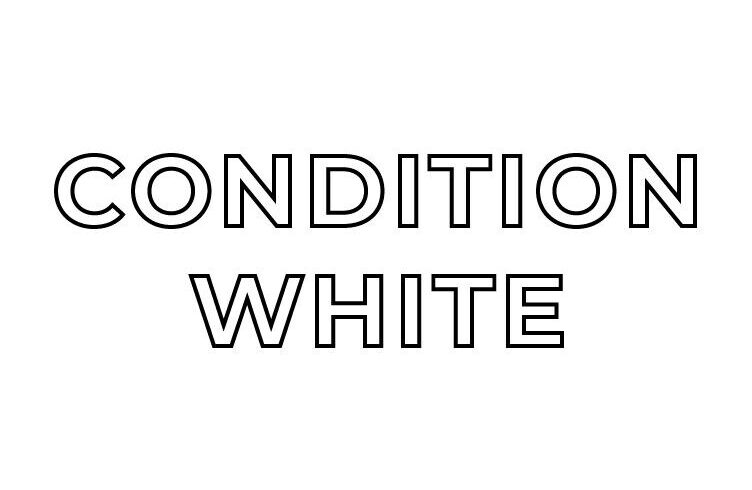
Unaware, Unprepared & Vulnerable to Threats
Condition White describes an unaware and unprepared state of awareness, making it the most dangerous level for self-defense awareness and readiness, as situational awareness is completely absent. You should aim to spend as little time as possible in Condition White when outside of safe, controlled environments. When you leave the house, you should leave Condition White. In Condition White, the only thing standing between you and harm is the attacker’s lack of ability or their choice to pursue a different victim.
Situational awareness is the foundation of effective avoidance, as staying alert and attuned to your surroundings enables you to identify potential threats before they escalate, allowing you to steer clear of dangerous situations. Without this heightened awareness, it’s difficult to recognize early warning signs or make informed decisions that keep you out of harm’s way. In essence, situational awareness enables you to anticipate risks and avoid confrontation altogether. A tragic example of the risk of being unaware and unprepared is highlighted in the London Random Assaults & Stabbing case.
Condition Yellow

Relaxed Alertness, Prepared & Ready For Threats
Condition Yellow is the ideal state of awareness when out in public or in unfamiliar situations. It represents a calm, yet alert mindset, where you are relaxed but conscious of your surroundings and prepared to respond if a threat arises. Unlike Condition White, where you’re unaware and unprepared, Condition Yellow keeps you mentally ready without being paranoid or tense. You haven’t identified any specific danger, but your general situational awareness allows you to keep your head on a swivel while assessing and anticipating potential risks around you. This balanced level of vigilance is key to maintaining your personal safety while still functioning normally in daily life.
Condition Yellow is only effective if you know what to watch for. Criminals often exhibit telltale signs through their body language, behaviors, or attempts to conceal weapons. Recognizing subtle cues, such as pre-assault indicators, deceptive behavior or suspicious body language, can give you the edge needed to act before it’s too late. Violent offenders, with the exception of highly trained or sociopathic individuals, will often reveal their intentions. By honing your ability to pick up on these signs, you significantly enhance your self-defense capabilities. (See Crime Signals by David Givens)
Condition Orange
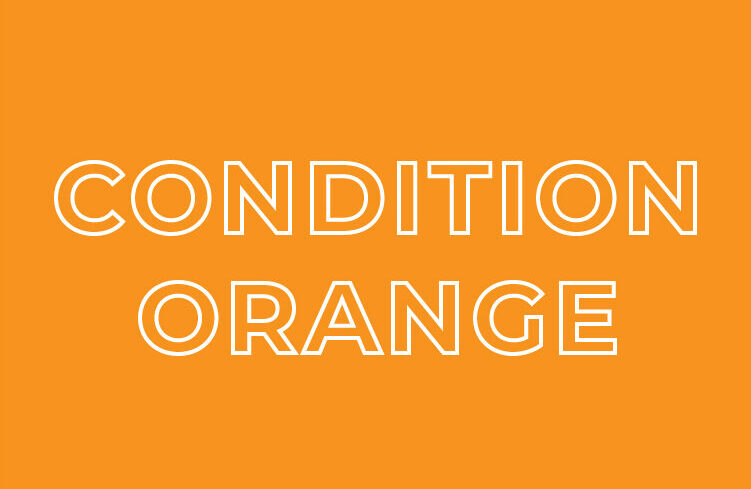
Specific Threat Identified, Preparing for Action
Condition Orange represents a critical shift in awareness, where a specific threat has been identified, and you’re mentally or physically preparing to take action. This heightened state is triggered by a warning—whether it’s a gut instinct, intuition, or clear indicators of danger. The key to Condition Orange is recognizing that a potential threat exists and taking proactive steps to prevent escalation. At this stage, you’re not panicking, but you’re no longer in a passive state of observation. You begin to analyze the threat, positioning yourself tactically and mentally rehearsing the necessary responses. Preventative measures become your priority, whether that means distancing yourself from the threat or readying yourself to act.
In Condition Orange, your focus narrows as you hone in on the potential danger. This makes it easy to lose sight of your broader surroundings, but it’s important to stay aware of the bigger picture. For example, a lone attacker may be a distraction for a secondary or group threat waiting to strike. Keeping situational awareness while analyzing the immediate risk is vital. At this point, you should mentally establish a “line in the sand”—a threshold that, if crossed by the threat, signals that it’s time for decisive action. This condition is about being alert and ready, understanding that you may have to move quickly from assessment to action. (See Shivworks “MUC” Online Course)
Condition Red

Hyper Aware & Prepared for Imminent Conflict
Condition Red represents the pinnacle of self-defense awareness—a hyper-alert state where the imminent threat of violence becomes undeniable. In this moment, you are acutely aware of the reality around you; every instinct and instinctual suspicion you’ve had has culminated into this critical realization. There’s no room for hesitation; the time for action is now. Your focus should be entirely on developing the most effective strategies to defend yourself and ensure your survival. This is not a moment to overthink or second-guess your instincts; it’s a call to immediate and decisive action.
Physiologically, your body reacts with a surge of adrenaline, leading to increased heart rate, heightened blood pressure, and rapid breathing. These changes prepare your body for action, sharpening your visual acuity while blurring peripheral details, allowing you to zero in on the threat at hand. As you ready for potential engagement, it’s essential to remain composed despite the physiological chaos. Although fine motor skills may diminish, your survival instincts will guide you. In Condition Red, the stakes are life and death, and maintaining a clear mind will empower you to navigate the dangerous encounter ahead, turning your fear into a calculated response.
Condition Black
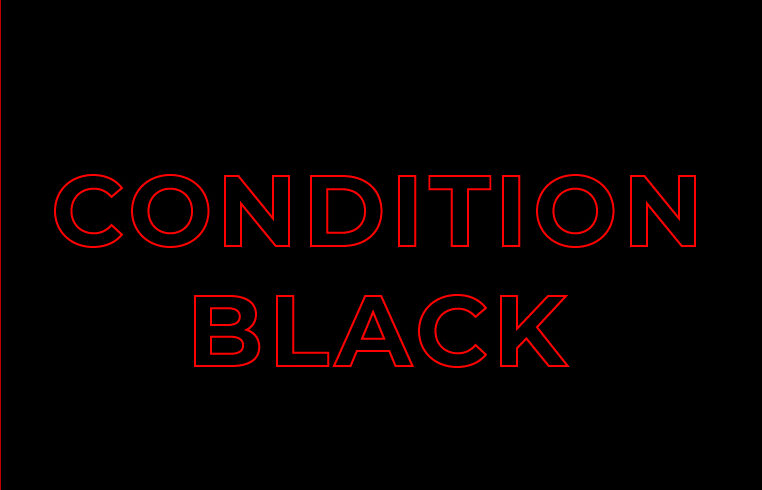
Critical Incident And Extreme Stress
Condition Black represents the most severe level of stress response, where both mental and physical performance deteriorate catastrophically. Originally adopted by the U.S. Marine Corps and not part of Jeff Cooper’s original system, Condition Black occurs when heart rates exceed 175 beats per minute. At this stage, cognitive function begins to break down, and fighters experience extreme physiological responses such as tunnel vision, auditory exclusion, and a loss of complex motor skills. One of the more intense reactions includes loss of bladder and bowel control, as the body prioritizes survival mechanisms over maintaining control of these functions. The body also undergoes extreme vasoconstriction, shunting blood away from the skin and toward vital organs and muscles, creating the familiar “white with fear” appearance. This same process helps reduce bleeding from potential wounds but comes at the cost of impaired dexterity and coordination.
The mental effects in Condition Black are equally severe. Higher-level thinking is essentially shut down, with the forebrain—responsible for executive function—ceasing to operate, leaving the primal brain to take over. This state can lead to irrational actions, such as fleeing from safety into danger or freezing altogether, rendering the individual incapable of responding to threats. In extreme cases, like those witnessed during wars, soldiers have been observed running into enemy fire without reason or freezing in place, both outcomes of being overwhelmed by stress. Condition Black is a worst-case scenario that is difficult to simulate in training, as no force-on-force drill can fully replicate the life-or-death stakes. (See On Combat by Dave Grossman)
CLOSING THOUGHTS
The Importance of Self-Defense Awareness and Readiness
In today’s unpredictable world, the significance of self-defense awareness and readiness cannot be overstated. Col. Jeff Cooper’s Color Code System serves as a vital framework for enhancing our situational awareness and preparing us to respond effectively to potential threats. By understanding and applying these principles, we empower ourselves to navigate our environments with confidence and clarity.
As you leave this discussion, remember that self-defense awareness is not just about physical techniques; it’s about cultivating a mindset that prioritizes safety and preparedness. By integrating Cooper’s Color Codes of Awareness into your daily life, you can enhance your ability to recognize and respond to threats, ultimately increasing your chances of navigating dangerous situations successfully. Stay vigilant, trust your instincts, and always be ready to act. Your safety depends on it.
6 Key Takeaways From This Blog Post
1. Awareness is Dynamic
Your level of awareness should adapt to your surroundings. Transitioning fluidly between the different conditions—White, Yellow, Orange, and Red—allows you to maintain a heightened state of readiness while avoiding the pitfalls of complacency.
2. Mental Preparedness is Crucial
The mind is your most powerful weapon in self-defense. Cultivating a combat mindset through mental rehearsal and visualization prepares you to react instinctively and decisively in high-pressure situations, reducing the likelihood of panic or hesitation.
3. Trust Your Instincts
Condition Yellow emphasizes the importance of being alert and aware of your environment. By honing your ability to recognize suspicious behaviors and potential threats, you can anticipate risks and take proactive measures to protect yourself.
4. Plan for Action:
In Condition Orange, you should actively assess threats and develop a response plan. Knowing how to react before a situation escalates can significantly enhance your chances of staying safe.
5. Stay Composed Under Pressure
Condition Red demands immediate action. Training yourself to remain calm and focused, even in the face of imminent danger, will enable you to execute your self-defense strategies effectively.
6. Continuous Learning and Adaptation
Self-defense is not a one-time lesson but a lifelong journey. Regularly practicing situational awareness, engaging in self-defense training, and refining your mental strategies will keep you prepared for whatever challenges may arise.

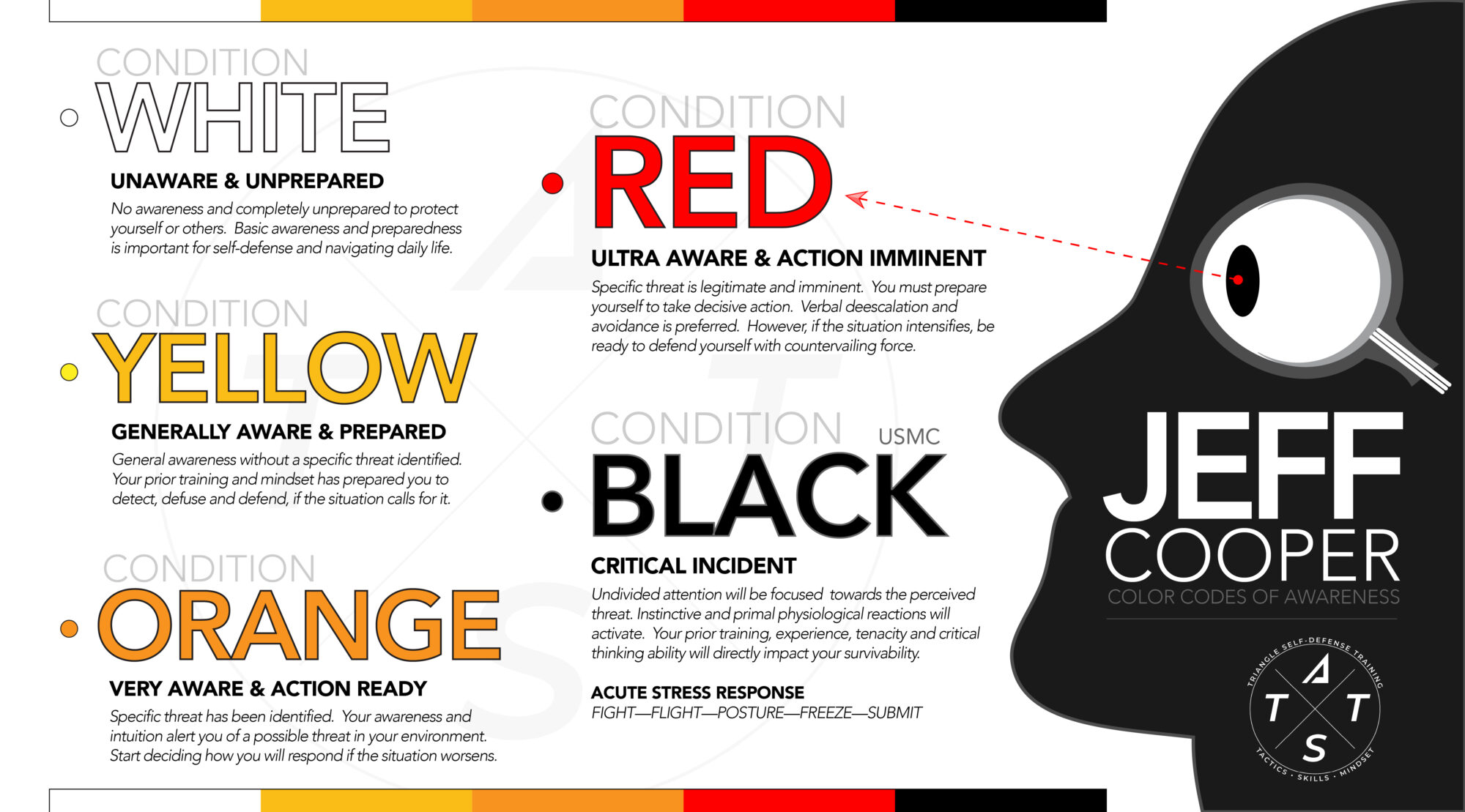

Comment